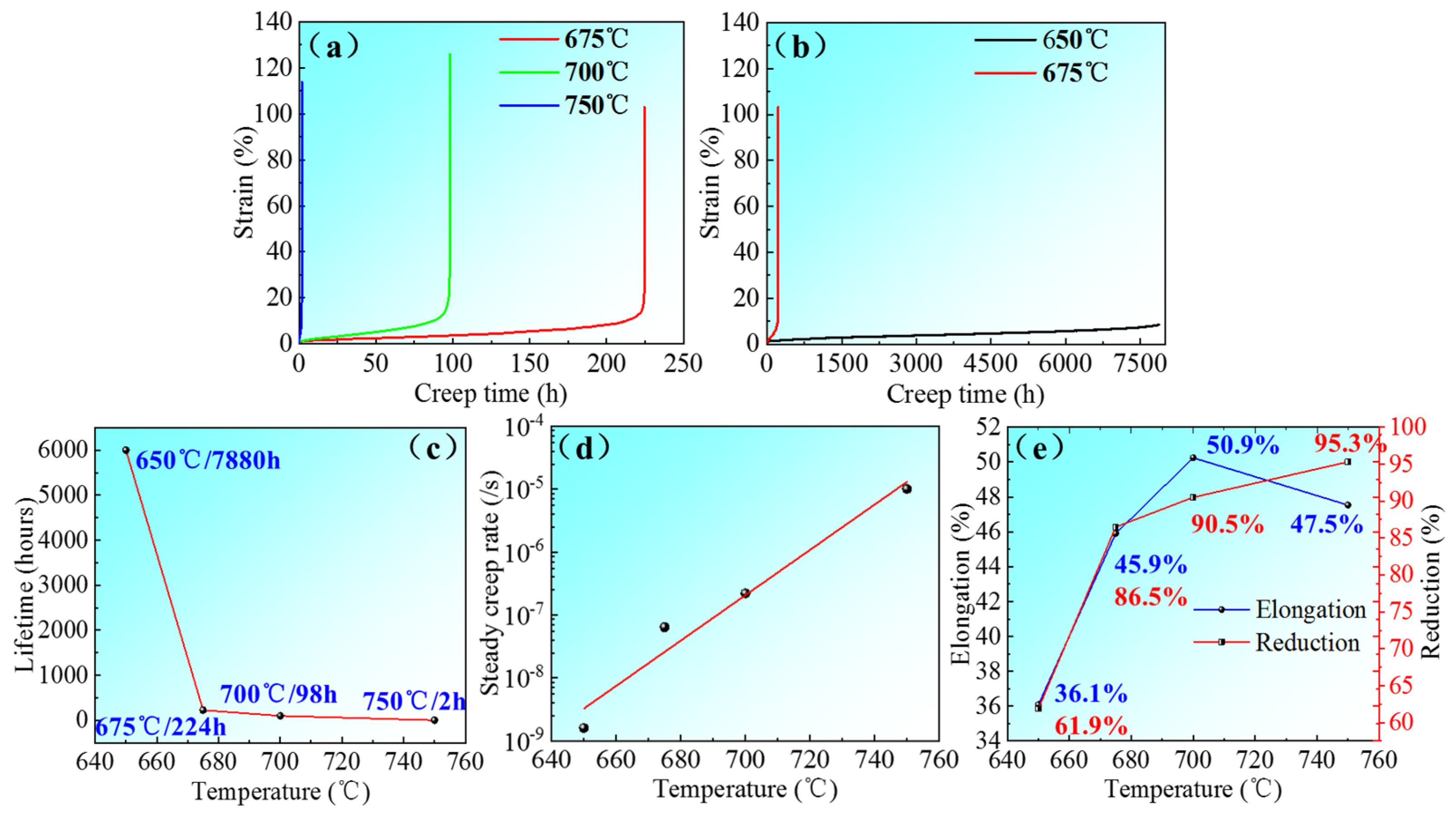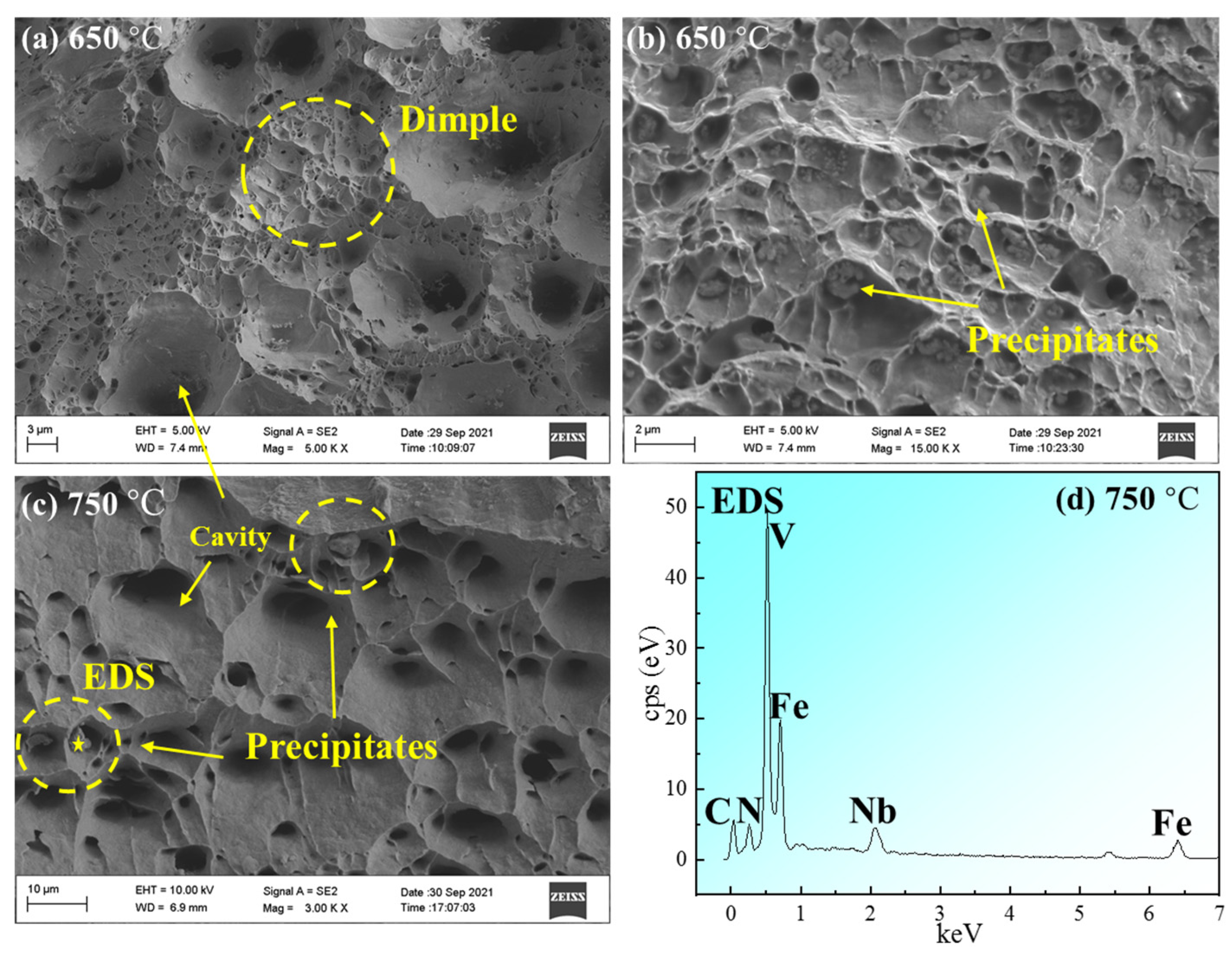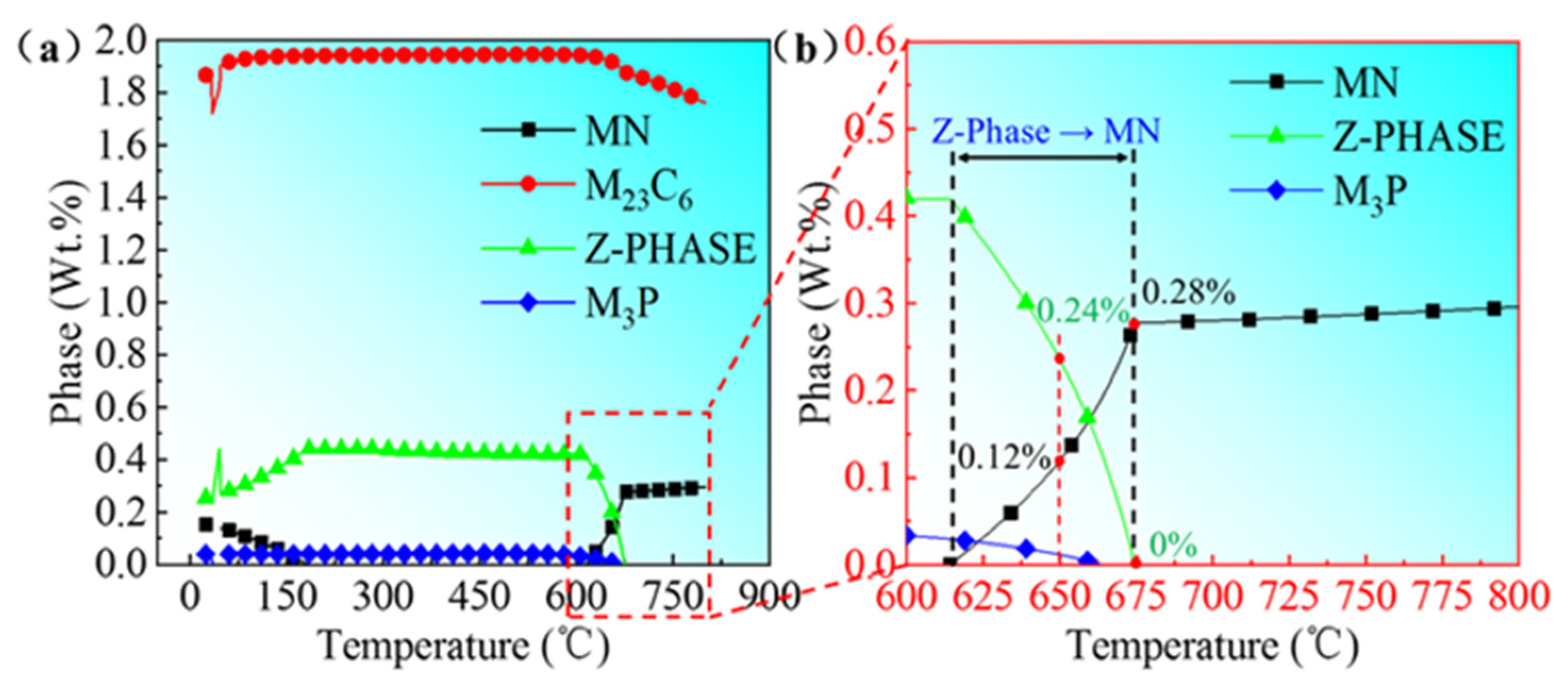Research on the Fracture Behavior and Microstructure of T91 Steel at Ultrahigh Creep Temperatures
Abstract
:1. Introduction
2. Materials and Methods
3. Results and Discussion
3.1. Creep Behavior
3.2. Fractography Examination
3.3. Precipitates
4. Conclusions
- (1)
- As the creep test temperature of T91 steel increases from 650 °C to 750 °C, the creep rate increases, the steady-state creep stage shortens, and the creep life decreases. The elongation increases initially, reaching a maximum at 700 °C, and then decreases slightly, whereas the section shrinkage increases consistently.
- (2)
- T91 steel exhibits significant plastic deformation at ultrahigh creep temperatures. As the creep temperature increases from 650 °C to 750 °C, the sample section shrinkage increases, and the fracture time decreases. The creep fracture time decreases rapidly from 650 °C to 675 °C, and T91 steel exhibits a strong susceptibility to failure.
- (3)
- The T91 steel precipitated phases along the grain boundaries are mainly M23C6-type carbides at ultrahigh creep temperatures, which have a strong pegging effect on dislocations and grain boundaries and can significantly improve the creep resistance. However, as the creep temperature increases, the creep resistance gradually decreases, which is primarily caused by the martensitic subcrystalline coarsening and transformation of the carbide morphology.
Author Contributions
Funding
Institutional Review Board Statement
Data Availability Statement
Conflicts of Interest
References
- Shrestha, T.; Basirat, M.; Charit, I.; Potirniche, G.P.; Rink, K.K. Creep rupture behavior of Grade 91 steel. Mater. Sci. Eng. A 2013, 565, 382–391. [Google Scholar] [CrossRef]
- Shrestha, T.; Basirat, M.; Alsagabi, S.; Sittiho, A.; Charit, I.; Potirniche, G.P. Creep rupture behavior of welded Grade 91 steel. Mater. Sci. Eng. A 2016, 669, 75–86. [Google Scholar] [CrossRef] [Green Version]
- Guguloth, K.; Roy, N. Study on the creep deformation behavior and characterization of 9Cr-1Mo-V-Nb steel at elevated temperatures. Mater. Charact. 2018, 146, 279–298. [Google Scholar] [CrossRef]
- Fan, P.; Liu, X.; Peng, J.; Zhu, L.; Zhang, K. Quantitative assessment of creep damage in 9Cr-1Mo steel using nonlinear Lamb wave. Mater. Charact. 2021, 171, 110771. [Google Scholar] [CrossRef]
- Sathyanarayanan, S.; Moitra, A.; Samuel, K.G.; Sasikalaa, G.; Ray, S.K.; Singh, V. Evaluation of dynamic fracture toughness based reference temperature (T-0(dy)) of modified 9Cr-1Mo steel in phosphorus embrittled and cold-worked condition. Mat. Sci. Eng. Struct. 2008, 488, 519–528. [Google Scholar] [CrossRef]
- Sawada, K.; Kushima, H.; Tabuchi, M.; Kimura, K. Microstructural degradation of Gr.91 steel during creep under low stress. Mater. Sci. Eng. A 2011, 528, 5511–5518. [Google Scholar] [CrossRef]
- Abe, F. Analysis of creep rates of tempered martensitic 9%Cr steel based on microstructure evolution. Mater. Sci. Eng. A 2009, 510–511, 64–69. [Google Scholar] [CrossRef]
- Choudhary, B.; Samuel, E.I. Creep behaviour of modified 9Cr–1Mo ferritic steel. J. Nucl. Mater. 2011, 412, 82–89. [Google Scholar] [CrossRef]
- Hald, J. Microstructure and long-term creep properties of 9–12% Cr steels. Int. J. Press. Vessel. Pip. 2008, 85, 30–37. [Google Scholar] [CrossRef]
- Abram, T.; Ion, S. Generation-IV nuclear power: A review of the state of the science. Energy Policy 2008, 36, 4323–4330. [Google Scholar] [CrossRef]
- Guguloth, K.; Roy, N. Creep deformation behavior of 9Cr1MoVNb (ASME Grade 91) steel. Mater. Sci. Eng. A 2017, 680, 388–404. [Google Scholar] [CrossRef]
- Wilshire, B.; Burt, H. Damage evolution during creep of steels. Int. J. Press. Vessel. Pip. 2008, 85, 47–54. [Google Scholar] [CrossRef]
- Pandey, C.; Mahapatra, M.; Kumar, P.; Vidyrathy, R.; Srivastava, A. Microstructure-based assessment of creep rupture behaviour of cast-forged P91 steel. Mater. Sci. Eng. A 2017, 695, 291–301. [Google Scholar] [CrossRef]
- Panait, C.G.; Zielinska-Lipiec, A.; Koziel, T.; Czyrska-Filemonowicz, A.; Gourgues-Lorenzon, A.F.; Bendick, W. Evolution of dislocation density, size of subgrains and MX-type precipitates in a P91 steel during creep and during thermal ageing at 600 degrees C for more than 100,000 h. Mat. Sci. Eng. Struct. 2010, 527, 4062–4069. [Google Scholar] [CrossRef] [Green Version]
- Pandey, C.; Mahapatra, M.M.; Kumar, P.; Saini, N. Comparative study of autogenous tungsten inert gas welding and tungsten arc welding with filler wire for dissimilar P91 and P92 steel weld joint. Mater. Sci. Eng. A 2018, 712, 720–737. [Google Scholar] [CrossRef]
- Pandey, C.; Giri, A.; Mahapatra, M. Evolution of phases in P91 steel in various heat treatment conditions and their effect on microstructure stability and mechanical properties. Mater. Sci. Eng. A 2016, 664, 58–74. [Google Scholar] [CrossRef]
- Tong, Z.; Dai, Y. The microstructure and tensile properties of ferritic/martensitic steels T91, Eurofer-97 and F82H irradiated up to 20dpa in STIP-III. J. Nucl. Mater. 2010, 398, 43–48. [Google Scholar] [CrossRef]
- Wakai, E.; Kikuchi, T.; Kim, B.; Kimura, A.; Nogami, S.; Hasegawa, A.; Nishimura, A.; Soldaini, M.; Yamamoto, M.; Knaster, J. Overview on recent progress toward small specimen test technique. Fusion Eng. Des. 2015, 98–99, 2089–2093. [Google Scholar] [CrossRef]
- Kumar, K.; Pooleery, A.; Madhusoodanan, K.; Singh, R.; Chatterjee, A.; Dutta, B.; Sinha, R. Optimisation of thickness of miniature tensile specimens for evaluation of mechanical properties. Mater. Sci. Eng. A 2016, 675, 32–43. [Google Scholar] [CrossRef]
- Sergueeva, A.; Zhou, J.; Meacham, B.; Branagan, D. Gage length and sample size effect on measured properties during tensile testing. Mater. Sci. Eng. A 2009, 526, 79–83. [Google Scholar] [CrossRef]
- Odette, G.; Yamamoto, T.; Kishimoto, H.; Sokolov, M.; Spätig, P.; Yang, W.; Rensman, J.-W.; Lucas, G. A master curve analysis of F82H using statistical and constraint loss size adjustments of small specimen data. J. Nucl. Mater. 2004, 329–333, 1243–1247. [Google Scholar] [CrossRef]
- Bonadé, R.; Spätig, P.; Baluc, N. Fracture toughness properties in the transition region of the Eurofer97 tempered martensitic steel. J. Nucl. Mater. 2007, 367–370, 581–586. [Google Scholar] [CrossRef]
- Wakai, E.; Nogami, S.; Kasada, R.; Kimura, A.; Kurishita, H.; Saito, M.; Ito, Y.; Takada, F.; Nakamura, K.; Molla, J.; et al. Small specimen test technology and methodology of IFMIF/EVEDA and the further subjects. J. Nucl. Mater. 2011, 417, 1325–1330. [Google Scholar] [CrossRef]
- Kohno, Y.; Kohyama, A.; Hamilton, M.L.; Hirose, T.; Katoh, Y.; A Garner, F. Specimen size effects on the tensile properties of JPCA and JFMS. J. Nucl. Mater. 2000, 283–287, 1014–1017. [Google Scholar] [CrossRef]
- Pandey, C.; Mahapatra, M.M. Effect of Long-term Ageing on the Microstructure and Mechanical Properties of Creep Strength Enhanced Ferritic P91 Steel. Trans. Indian Inst. Met. 2016, 69, 1657–1673. [Google Scholar] [CrossRef]
- Shrestha, T.; Basirat, M.; Charit, I.; Potirniche, G.P.; Rink, K.K.; Sahaym, U. Creep deformation mechanisms in modified 9Cr–1Mo steel. J. Nucl. Mater. 2012, 423, 110–119. [Google Scholar] [CrossRef]
- Haney, E.M.; Dalle, F.; Sauzay, M.; Vincent, L.; Tournié, I.; Allais, L.; Fournier, B. Macroscopic results of long-term creep on a modified 9Cr–1Mo steel (T91). Mater. Sci. Eng. A 2009, 510–511, 99–103. [Google Scholar] [CrossRef]
- Rabotnov, Y.N.; Leckie, F.A.; Prager, W. Creep Problems in Structural Members. J. Appl. Mech. 1970, 37, 249. [Google Scholar] [CrossRef]
- Phaniraj, C.; Choudhary, B.; Rao, K.B.S.; Raj, B. Relationship between time to reach Monkman–Grant ductility and rupture life. Scr. Mater. 2003, 48, 1313–1318. [Google Scholar] [CrossRef]
- Ali, H.O.; Tamin, M.N. Modified Monkman–Grant relationship for austenitic stainless steel foils. J. Nucl. Mater. 2013, 433, 74–79. [Google Scholar] [CrossRef]
- Sawada, K.; Kushima, H.; Kimura, K. Z-phase Formation during Creep and Aging in 9–12% Cr Heat Resistant Steels. ISIJ Int. 2006, 46, 769–775. [Google Scholar] [CrossRef] [Green Version]
- Chen, R.; Armaki, H.G.; Maruyama, K.; Igarashi, M. Long-term microstructural degradation and creep strength in Gr.91 steel. Mater. Sci. Eng. A 2011, 528, 4390–4394. [Google Scholar] [CrossRef]
- Agamennone, R.; Blum, W.; Gupta, C.; Chakravartty, J. Evolution of microstructure and deformation resistance in creep of tempered martensitic 9–12%Cr–2%W–5%Co steels. Acta Mater. 2006, 54, 3003–3014. [Google Scholar] [CrossRef]
- Kimura, K.; Kushima, H.; Sawada, K. Long-term creep deformation property of modified 9Cr–1Mo steel. Mater. Sci. Eng. A 2009, 510–511, 58–63. [Google Scholar] [CrossRef]








| Cr | Mo | V | Nb | N | Mn | Si | C | Ni | Al | P | S | Cu | Na |
|---|---|---|---|---|---|---|---|---|---|---|---|---|---|
| 9.02 | 0.92 | 0.2 | 0.072 | 0.049 | 0.42 | 0.32 | 0.1 | 0.065 | 0.012 | 0.0066 | <0.002 | 0.024 | 0.018 |
| Creep temperature (°C) | 650 | 675 | 700 | 750 |
| Calculated value | 7.95 | 8.86 | 6.44 | 7.33 |
Publisher’s Note: MDPI stays neutral with regard to jurisdictional claims in published maps and institutional affiliations. |
© 2022 by the authors. Licensee MDPI, Basel, Switzerland. This article is an open access article distributed under the terms and conditions of the Creative Commons Attribution (CC BY) license (https://creativecommons.org/licenses/by/4.0/).
Share and Cite
Zheng, Q.; Zhong, W.; Bai, B.; Yang, W.; Wang, Z.; Huang, C. Research on the Fracture Behavior and Microstructure of T91 Steel at Ultrahigh Creep Temperatures. Metals 2022, 12, 2054. https://doi.org/10.3390/met12122054
Zheng Q, Zhong W, Bai B, Yang W, Wang Z, Huang C. Research on the Fracture Behavior and Microstructure of T91 Steel at Ultrahigh Creep Temperatures. Metals. 2022; 12(12):2054. https://doi.org/10.3390/met12122054
Chicago/Turabian StyleZheng, Quan, Weihua Zhong, Bing Bai, Wen Yang, Zhigang Wang, and Chengcong Huang. 2022. "Research on the Fracture Behavior and Microstructure of T91 Steel at Ultrahigh Creep Temperatures" Metals 12, no. 12: 2054. https://doi.org/10.3390/met12122054




